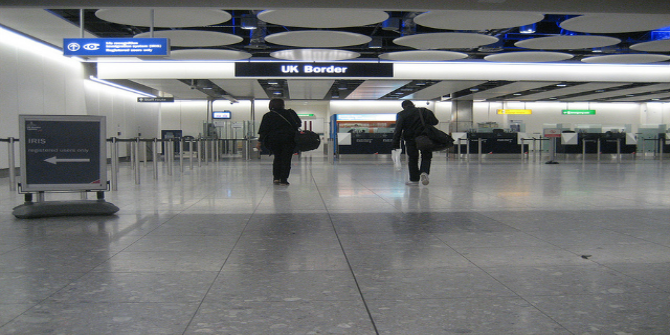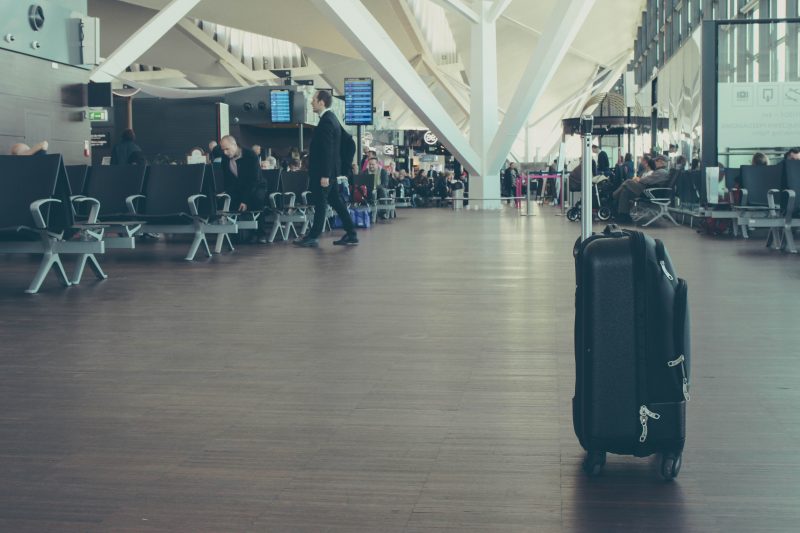 The attempt to control some people can all too quickly escalate into an effort that depends for success on controlling everyone, argues Chandran Kukathas in comparing immigration controls with South Africa’s notorious apartheid laws.
The attempt to control some people can all too quickly escalate into an effort that depends for success on controlling everyone, argues Chandran Kukathas in comparing immigration controls with South Africa’s notorious apartheid laws.
The governments of most European states are eager for foreigners to enter their countries and often boast of their success in attracting people to come in as tourists, whose spending boosts certain industries and swells state treasuries. They want high fee paying students, or wealthy investors willing to set up businesses, or specialist workers in short supply, be they engineers or footballers or nurses. Foreigners are welcome, if they are of the right kind, come for the right reasons, and stay for the right length of time. The more the merrier. Provided everything is kept under control. But control—even attempted control—comes at a cost. One of those costs is the freedom of citizens and residents.
Here’s where immigration controls in liberal democracies and apartheid in South Africa after 1948 share some similarities. In both cases the effectiveness of the policies depends in the end on controlling not just outsiders but also insiders – citizens and residents. It is widely assumed that immigration control is a matter of keeping people from entering a country, and the rhetoric of control encourages this impression. Cities, public facilities, and social services are routinely described as bursting at the seams or stretched to the limit, unable to cope with sudden influxes of large numbers of foreigners, or the growth of a population swelling steadily because of a positive rate of net migration.
But a little reflection should tell us that the key is to control not so much movement across borders as what people do within borders. It’s really not simply about numbers, and certainly not about foreigners crossing borders. Regulating immigration is not just about how people arrive, but about what they do once they have entered a country. It is about controlling how long people stay, where they travel, and what they do. Most of all, it means controlling whether or not and for whom they work (paid or unpaid), what they accept in financial remuneration, and what they must do to remain in employment, for as long as that is permitted. Yet this is not possible without controlling citizens and existing residents, who must be regulated, monitored and policed to make sure that they comply with immigration laws.
This should come as no surprise. Immigrants are not readily discernible from citizens, or from residents with ‘Indefinite Leave to Remain’, especially in a multi-ethnic and multi-cultural society. So any effort to identify and exclude or penalize immigrants will generally require stopping or searching or questioning anyone. If immigrants must show their passports at borders, everyone will have to, including returning citizens. If immigrants must present their credentials at internal checkpoints, then everyone, including citizens, will have to do so—if only to prove that they are not immigrants.
But the extent of the intrusion must go deeper. Prime Minister David Cameron promised to strengthen the UK’s internal borders through deportation and a crackdown on housing entitlements. ‘Since I have become Prime Minister,’ he said, ‘we have made it harder to get a driving license, to get a bank account, to get a council house. We have removed more people. All of these actions – the internal border – matter, as it were, as well as the external border.’ Yet making these things harder for immigrants must also make things harder for existing residents and citizens. If an immigrant must prove that he or she has a right to rent, so must a citizen prove that he or she is not an immigrant who lacks that right. And the landlord must assume the burden of verifying that his tenants are entitled to rent—and that the right has not expired in the course of the tenancy.
Immigration controls are controls on people, and it is difficult to control some people without also controlling others. Sometimes it is because it is not easy to distinguish those over whom control is sought from those who are considered exempt. At other times it may be because it is not possible to restrict particular persons save by coopting others without whose cooperation success would be impossible. And on occasion it may be necessary in order to control a few to put the liberty of almost everyone into abeyance. Immigration controls are not unique in this respect—the logic of human control is everywhere the same.
This was the logic of Apartheid. Controlling who could enter from the bantustans required controlling the movement of black people within white society. The so-called ‘pass laws’ that first appeared in the nineteenth century to limit and control the movement of black labour, were extended to require both male and female Africans to carry ‘reference books’ detailing among other things, employment record, marital status, taxes paid, and official place of residence—and failure to carry the ‘dompas’ eventually became a criminal offence punishable by a prison sentence. By 1970 not only Blacks but also Whites, Coloureds and Asians were issued with (though not all were obliged to carry) similar documents under the Population Registration Amendment Act. Even when it is possible to identify some people readily, by skin colour or other other visible characteristics, it is not easy to control them without controlling others.
It is tempting to dismiss the analogy between Apartheid and immigration controls. South Africa was until 1994 an avowedly racist state, which not only restricted movement, and regulated labour markets (to protect white wages), but also used extreme violence to suppress dissent. But the aim of the analogy is not to suggest any identity between Apartheid South Africa and states with immigration controls. The point is rather to draw attention to the way in which the control of some quickly comes to require the control of all. In the South African case, controlling black Africans necessitated building an institutional structure that involved controlling blacks, coloureds and whites alike. In the end, it meant monitoring white newspapers, prohibiting intermarriage, conscripting white men to strengthen the security arms of government, controlling the local as well as the foreign media, censoring books, films and music, strong-arming the courts, and using force against all citizens.
When immigration controls fail to achieve their ends, governments are invariably pressured or tempted to extend that control in a way that bites into the freedom of ordinary residents and citizens. Employers, landlords, and educational institutions are subjected to harsher punishments for hiring, housing or hosting would-be immigrants, and are in the process turned into agents of the state, obliged while trying to run their own affairs also to do the work of regulating, monitoring and reporting to the government in order to preserve their right to operate—or to stay out of jail. People will find their relatives deported for babysitting their children u.paid but unauthorized (as happened to Mrs Wang in Yorkshire in 2009); men and women will find themselves unable to bring their spouses into the country even when married with children (as happened to Elizabeth Celi-Parr, who was refused permission to sponsor her Ecuadorian husband to enter the UK because her earnings were too low); and universities will find themselves unable to operate when their licenses to admit foreign students are withdrawn for failure to monitor closely enough classroom attendance and visa compliance (as happened to London Metropolitan University in 2013).
As the pressure to maintain or reduce immigration numbers in accordance with stated targets increases, so will the likelihood of injustice against residents and citizens. Since 1930 more than one million U.S. citizens have been deported from their own country—most of them wrongly assumed to be undocumented Mexicans when they were simply Americans who, as citizens, have never been under any obligation to carry any documentation.
Note: This article was originally published on the Democratic Audit blog. Featured image credit: Jasonwhat CC BY 2.0
 Chandran Kukathas is Professor of Political Theory and Convenor (Head of Department) in the Department of Government, LSE. He previously worked at the University of Utah, Oxford and in Australia. Chandran is the author of The Liberal Archipelago: A Theory of Diversity and Freedom. He is currently working on a book entitled Immigration and Freedom.
Chandran Kukathas is Professor of Political Theory and Convenor (Head of Department) in the Department of Government, LSE. He previously worked at the University of Utah, Oxford and in Australia. Chandran is the author of The Liberal Archipelago: A Theory of Diversity and Freedom. He is currently working on a book entitled Immigration and Freedom.








I cannot think of a more inappropriate comparison to make. Brazil demands that employers justify why a Brazilian citizen cannot do the job that they want to offer to a foreign citizen. Is that comparable with apartheid or is it basic common sense in a country which has high unemployment?
The UK has 5 million unemployed and underemployed people – with people from ethnic minority backgrounds disproportionately affected. Why do they need greater competition for jobs and housing?
Why are you advocating an ideology which requires ever more economic growth to make it work when economic growth is wrecking the environment and the Western world has already had more than its fair share?
What a load of nonsense wanting to control who migrates or even visits your country is nothing like apartheid this is just a nonsensical claim.
Demand for migration rights is a concommittant and complementary to economic and tecknolocal globalization.
Migration fas two faces:.for permanent settlement of one’s choice place on earth and other is for mere carrying of travel, trade and business and tourism..
The permanent settlement is connected to local citizenship political rights for protection of their natural right to ,lingustic, cultural,racial,ethnic etc identities and conservation issues corresponding to the present civilisational stage. The other is general universal global citizenship rights connected to globalisation rights which should include global governing political citizenship rights. Their is in fact no repugnance in the general global citizenship rights and local citizenship rights as a dual citizenship..
Who grants and enforces the dual citizenship rights? You academicians should address the issues by deducing historical processes and precedents in law courts and from other sources.
The present huge migration and refugee criss and its causuative factors for such mass migration to Europe and other places is profusely being discussed in various forums and global media.it is good.
one should also pay attention over economic and tecknical globalisation with power analogous to electromagnetic currents and forces sweeping across the global markets in spite of obstacles being erected by national miopic governments against free flow of capitals and labor across their borders and the middle east disturbances and regime changes politics and violence reflects this conflict.the economic globalisation demands right to free movement from unnecessary immigration laws and defences of particular local interests and identify politics opposes such disequilibrating and disturbating migrants as stated at the beginning. The conflict in ukrain and middle east as well as in several countries within europe and many other parts of world have such potentials and all are rooted in globalisation effects on individuals,social and economic groups of people and they should be resolved without any threat to globalizatiin process? Global rule of law suppression of prevalency of ideas of might is right and establishment no federal democratic global sovereign power in UN .should be the direction to move.
All countries must move such direction and it is the political consensus required to avoid historical repetition of political blunders resulting civilisational threats.
I do think the language by the media/newspapers and other journalists have been compassionate towards “immigration” – but often fail to breakdown for the public or population the difference between “immigration” and refugee and economic refugees – all of which have different consequences on the economy, local services and communities.
What is most SHOCKING is that NON of the newspapers and journalists seem to mention a Coverage they were Engaged on a regular basis, over many months and years – it is that the so-called ISIS said “we will use refugees to cause TERROR in Europe..” Why is this statement now not a mention by the media and journalists?
Finally, Balancing public RISK is key to addressing the “immigration” differences and Terrorism, right!!
Thus, many will feel that the media/newspapers have been Compassionate with their HEART, but have FAILED to be balanced in their assessment of RISK – as they themselves reported and printed this ISIS statement about using refugees to cause Terror on UK.. streets, WHY has this Mind-set now been LOST??
Comparing immigration controls to apartheid is merely rhetoric. The duty of an academic is to analyse and to propose remedies. Rhetoric has its place, but that place is not on a blog sponsored by a Russell Group university.
“Abolish immigration controls” could mean one of two things. Either, that they are abolished by international agreement (after all, far more people wish to migrate to the USA than to Western Europe) or, that one country (presumably the UK, since that’s where Professor Kukathas is writing from) should do so unilaterally. I cannot discover from his article which of these proposals Professor Kukathas prefers.
Mind you, there’s nothing in his article to suggest that believes that apartheid has been abolished, either.
A rather useful contribution to a motion for debate which I assigned to an undergrad class – “Discrimination by citizenship is acceptable”. This article draws out issues I had not really considered previously.